XXVII - Invasive Diagnostic Investigations and Surgical Approaches
Editors: Shields, Thomas W.; LoCicero, Joseph; Ponn, Ronald B.; Rusch, Valerie W.
Title: General Thoracic Surgery, 6th Edition
Copyright 2005 Lippincott Williams & Wilkins
> Table of Contents > Volume II > The Mediastinum > Section XXIX - Primary Mediastinal Tumors and Syndromes Associated with Mediastinal Lesions > Chapter 190 - Excision of Hourglass Tumors of the Paravertebral Sulcus
Chapter 190
Excision of Hourglass Tumors of the Paravertebral Sulcus
A. John Popp
Makoto Goda
Darryl J. DiRisio
Darroch W.O. Moores
Hourglass tumors of the thoracic paravertebral sulcus present with a constellation of anatomic, pathologic, and surgical considerations that make their treatment unique. The appellation hourglass tumor refers to a lesion with an intraspinal component and an intrathoracic component connected by a narrow waist of tumor, the growth of which has been restricted by the confines of the bony intervertebral foramen. In the series of 706 neurogenic tumors of the thoracic paravertebral region reported by Akwari and colleagues (1978), nearly 10% were found to have extension into the spinal canal. In patients where the source of the tumor was reported, 68% were nerve sheath in origin, 30% originated from the sympathetic chain, and 2% arose from paraganglion cells. Overall, 10% of the neurogenic hourglass tumors were malignant. In addition to neurogenic lesions, a number of other mesenchymal tumors, such as hemangiomas, other blood vessel tumors, and lipomas, also may grow into the spinal canal when they originate in the paravertebral sulcus.
ANATOMIC CONSIDERATIONS
The anatomic features that influence the surgical approach to hourglass lesions of the thoracic spine include the proximity of the pleural cavity, the presence of ribs, and the osseous and neural anatomy.
The thoracic spinal column contains 12 segments. The spinal canal is delimited ventrally by the vertebral bodies and the interposed discs and dorsally by the spinous processes, paired laminae, facet joints, and pedicles. Twelve paired ribs articulate with the vertebral bodies at the diarthrodial joints. The intervertebral foramen (Fig. 190-1) is formed cephalad and caudad by the pedicles, dorsally by the superior and inferior articular facets, and ventrally by the contiguous vertebral bodies and interposed disc.
The spinal cord and the proximal portion of the emerging nerve roots are contained within the spinal canal (Fig. 190-2). Surrounding the neural tissues are three layers of the meninges: the dura mater, arachnoid, and pia mater. The arachnoid envelope contains cerebrospinal fluid. The subarachnoid space extends a variable distance along the nerve root; thus, if the nerve root must be sacrificed during tumor resection, unrecognized arachnoid injury may result in a spinal-pleural cerebrospinal fluid fistula.
Radicular arteries enter the intervertebral foramina to perfuse the intraspinal structures. Spinal medullary branches arise from the radicular arteries to supply the spinal cord. Radicular branches are random and do not enter every intervertebral foramen in the thoracic region. Attempts should be made to preserve the radicular blood supply, although sacrifice of a radicular artery might be necessary to fully resect an hourglass tumor, thereby threatening circulation to the spinal cord. Despite this concern, neural impairment secondary to spinal cord infarction caused by vascular sacrifice rarely occurs, perhaps because most hourglass tumors are slow growing and the resultant gradual occlusion of important nutrient vascular channels allows for the development of collateral circulation.
The complexity of osseous, vascular, and neural anatomy encountered in the thoracic region complicates the operative approach to hourglass tumors. Unlike the lumbar region, where the spinal cord is absent, the presence of the spinal cord in the thoracic region renders a posterior approach to the spinal canal unsafe. Unlike the cervical region, where the presence of the spinal cord also requires careful planning of the operative approach, the presence of ribs and the pleura in the thoracic region complicate the surgical exposure.
CLINICAL PRESENTATION
An hourglass tumor may be asymptomatic and found on routine chest radiography (Fig. 190-3) or may present with
P.2758
either pulmonary or neurologic symptoms. Akwari and colleagues (1978) noted that approximately one third of the hourglass tumors were asymptomatic. Tumors with a large intrathoracic component may produce shortness of breath or cough. Neurologic deficits may be caused by spinal cord compression or involvement of nerve roots (Fig. 190-4). Patients with myelopathy may present with gait difficulty, urinary and fecal incontinence, and loss of sensory and autonomic function below the level of the lesion. Those with radicular symptoms may present with radicular pain at the level of the tumor, and on examination, altered sensation may be found in a dermatomal distribution. Rarely, patients with an upper thoracic tumor may present with Horner's syndrome due to sympathetic chain compression. The clinical manifestations of this syndrome include pupillary miosis, eyelid ptosis, and anhydrosis of the face and neck ipsilateral to the lesion.
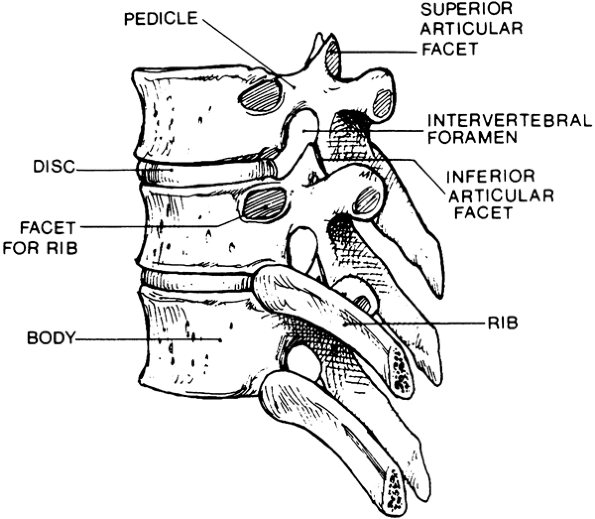 |
Fig. 190-1. Lateral view of a segment of the thoracic spine demonstrating the intervertebral foramen. |
 |
Fig. 190-2. Diagram of cross-sectional view of the thoracic spine and surrounding structures. |
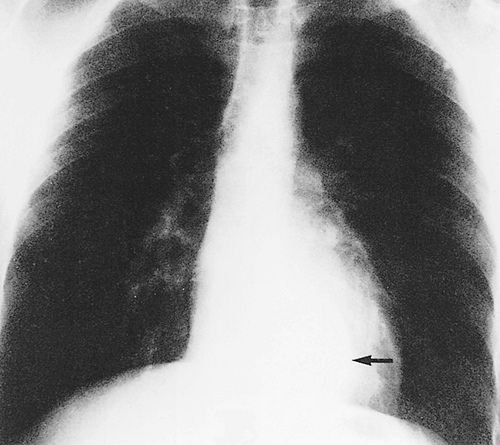 |
Fig. 190-3. Posteroanterior chest radiograph. Arrow indicates location of an asymptomatic hourglass neurogenic tumor. |
DIAGNOSTIC INVESTIGATION
All patients being investigated for a paravertebral mass must also be evaluated for intraspinal extension. Assessment
P.2759
begins with a history and physical examination followed by diagnostic studies that may include plain radiographs of the thoracic spine, coned-down computed tomographic (CT) scan, magnetic resonance (MR) imaging, and CT/myelography. Imaging used to evaluate patients with hourglass lesions has evolved considerably since the late 1980s with the introduction of high-resolution CT scanning and MR imaging. Prior to the development of newer imaging modalities, diagnosis depended on using plain radiography to identify an enlarged or eroded neural foramen in a patient with a paravertebral tumor. Myelography/CT is still occasionally used to define the intraspinal component of the tumor, but MR imaging (Fig. 190-5) has become the single best examination to disclose the characteristic shape and extent of the tumor. Spinal angiography is used occasionally to add information about blood supply to the tumor and spinal cord, particularly with lower thoracic tumors when perfusion by the artery of Adamkiewicz becomes more likely. However, the risk for spinal angiography outweighs any potential benefit in most instances.
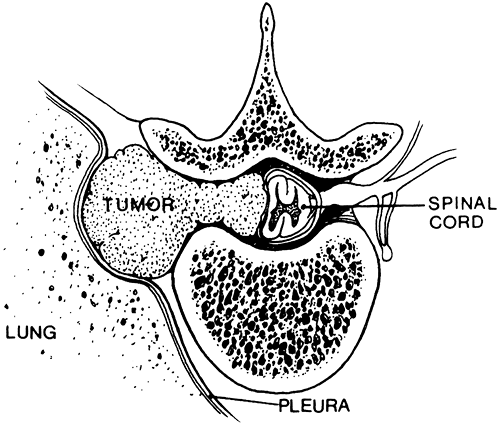 |
Fig. 190-4. Diagram of an hourglass tumor with the intraspinal component compressing the spinal cord and emerging nerve, and an intrathoracic component elevating the pleura and compressing the lung. |
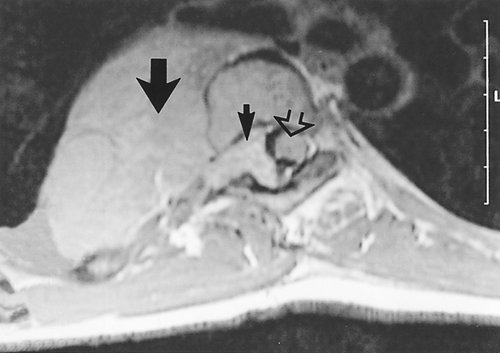 |
Fig. 190-5. MR imaging demonstrates narrow waist of tumor connecting large intrathoracic neurofibroma (large arrow) with smaller intraspinal component (small arrow). Note enlargement of the neural foramen and the displaced spinal cord (open arrow). |
OPERATIVE CONSIDERATIONS
Surgery for hourglass tumors of the thoracic spine requires entrance into two distinct anatomic regions: the thorax and spinal canal. Staged procedures for removal of hourglass tumors are not recommended. If only the intraspinal or intrathoracic component is removed at the initial setting, serious complications, such as hemorrhage, spinal cord injury, or cerebrospinal fluid leak may occur. It is therefore important that the presence of intraspinal extension be determined prior to planning the surgical procedure so that total tumor resection can be achieved and risk to the patient minimized.
Harrington and Craig (1934) reported the first case of an hourglass neurogenic tumor removed by a one-stage procedure. Since that time, numerous surgeons, including Irger (1975, 1980), Akwari (1978), and Grillo (1983) and their associates as well as Le Brigand (1973), Shields and Reynolds (1988), and Grillo and Ojemann (1989), have described and advocated a single-stage operative approach.
Most hourglass tumors can be resected using either a lateral extracavitary approach or a combined anteroposterior approach: performing a laminectomy for resection of the intraspinal component and either a thoracotomy or thoracoscopic resection of the intrathoracic component. However, surgical planning for resection of hourglass tumors must take into account multiple factors. For example, the precise anatomic site of the tumor often defines the necessary operative procedure. Lesions that are completely intrathoracic, with minimal extension into the spinal canal, may be removed by thoracotomy or thoracoscopy alone. However, great care must be taken with resection of the foraminal extension of the tumor. Those tumors mostly located within the spinal canal, with little extraforaminal extension, may be resected by performing a laminectomy and foraminotomy, thus obviating the need for a thoracotomy.
Biomechanical factors must also be considered. Significant vertebral body erosion, often seen with malignant lesions, and some benign entities, may necessitate reconstruction with vertebral body replacement (anterior column support) and posteriorly placed pedicle screws or hooks. Spinal instrumentation allows for immediate spine stabilization. Anterior plating systems, useful in the lower thoracic spine, provide stability by resisting extension and rotational moments. Posterior instrumentation techniques use hooks and pedicle screws that resist flexion and rotation. Instrumentation is not a substitute for proper bone grafting, because long-term stability often depends on bone healing. In the absence of bone healing, instrumentation failure will occur.
The level of involvement of the thoracic spine is also an important consideration. Middle to lower thoracic lesions with a large intrathoracic component are easily approached by performing a thoracotomy with a separate posterior midline incision for the intraspinal portion of the tumor. However, those lesions located above T3 may be better exposed by dissecting lateral to the spine and medial to the scapula (lateral parascapular approach). This approach is similar to a lateral extracavitary approach used in the lower thoracic spine. For lesions at the thoracic inlet, an anterior cervical incision can be extended caudally to the sternal notch.
Lateral Extracavitary Approach (Lateral Parascapular Approach)
The patient is positioned on the operating table in the lateral position and rolled slightly forward (Fig. 190-6). The patient is supported by a beanbag (Olympic Vac-Pac, Olympic Medical, Seattle, WA, U.S.A.) and is held by wide
P.2760
strips of adhesive tape over the hip to secure the patient to the operating table. The lower arm can either be placed on an arm board at a right angle to the table or be flexed at the elbow and placed beside the patient's head. The upper arm may be rotated forward, abducted, flexed at the elbow, and placed on an arm support; however, in our experience it is more convenient to rotate the arm forward and let it hang over the side of the table, protected by adequate padding. The patient is prepared and draped widely to allow for both exposure of the spine and for a full thoracotomy, if necessary.
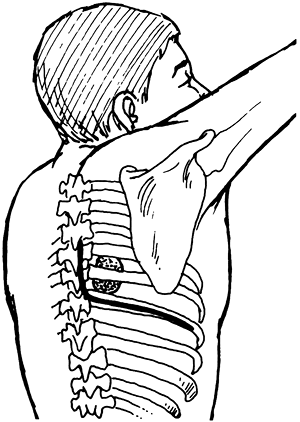 |
Fig. 190-6. Patient positioned on operating table showing recommended incision for tumor at level shown in diagram using lateral extracavitary approach. |
As described previously, the location of the incision depends on the site of the lesion. The vertical component of the incision starts in the midline over the spinous processes, approximately 5 cm above the level of the foramen to be explored and extends caudad to approximately 5 cm below the level of the foramen to be explored, at which point the incision curves sharply laterally and follows the course of the rib. For lesions above the tip of the scapula, the incision curves anteriorly just below the scapula tip; the anterior aspect of the incision follows the rib just below the foramen to be explored in a fashion similar to a standard posterolateral thoracotomy incision. The vertical portion of the incision is made down to the spinous process; the paraspinal muscle mass is elevated from the spinous processes and laminae and retracted laterally.
A bilateral laminectomy is performed, including the level above and below the site of the involved foramen. If the tumor is completely in the extradural space, it may be reduced from the spinal canal into the thorax and completely removed. If the tumor is partially intradural, the dura is opened laterally over the tumor and the intraspinal component of the lesion is separated from the spinal cord using microsurgical techniques. Use of the Cavitron ultrasonic surgical aspirator (Valley Id Lab., Boulder, CO) greatly aids this dissection if the tumor is not calcified. For complete removal of the tumor, it is usually necessary to enlarge the foramen by removing the roof of the foramen. For tumors arising from a nerve root, the nerve root is divided just proximal to the site of its entrance into the medial surface of the tumor; little discernible deficit occurs from sacrifice of a thoracic nerve root except at the higher levels (T1, T2), where hand function can be compromised. After resection of the tumor, the dura is closed. A dural graft is used if necessary and the foramen is sealed using muscle, Gelfoam pledgets, and Fibrin Glue (Hemaseel APR, Haemacure Corporation, Sarasota, FL, U.S.A.) to prevent a spinal fluid leak. The integrity of this closure may be tested by having the anesthesiologist induce a Valsalva maneuver.
Attention is then directed to the thoracic exposure if necessary. The subcutaneous tissue and superficial fascia are incised until the fascia overlying the latissimus dorsi, trapezius muscle, and paravertebral muscle are exposed. The posterior aspect of the latissimus dorsi is divided. The trapezius and rhomboid muscles are divided as necessary. Once the rib overlying the tumor is identified, dissection is executed posterior to the rib, anterior to the paraspinal muscle, and medially toward the transverse process. Once the paraspinal muscle is mobilized, a vessel loop can be placed around it for easy retraction. Next, the rib is freed from the underlying parietal pleura and resected, maintaining the neurovascular elements intact. Using a sponge stick, the parietal pleura is bluntly separated from the tumor. The tumor can then be dissected free from its vascular supply and resected.
The chest is drained by tube thoracostomy and the incision is closed in standard fashion using No. 2 polyglycolic acid (PGA) suture for pericostal closure, 4 0 Neurilon on the dura mater, No. 1 PGA on the thoracolumbar fascia, 3 0 PGA on the subcutaneous tissue, and 3 0 PGA, nylon, or staples on the skin.
Posteroanterior Approach
A more anterior approach is afforded by performing a separate thoracotomy to resect the intrathoracic portion of the dumbbell tumor. Once again, it is crucial that the spinal portion of the tumor be resected first, because failure to respect
P.2761
this sequence of surgical steps could potentially result in spinal cord injury from traction on the cord or from a hematoma.
After being intubated with a double-lumen tube, the patient is positioned on a bean bag, in a lateral decubitus position lying on the nontumor side. All bony prominences are padded, especially the lateral portion of the dependent knee near the fibular head, where peroneal nerve compression could result in the loss of sensation on the dorsum of the foot or a foot drop. The dependent arm is appropriately padded after an axillary roll is placed, and the nondependent arm can be extended in a sling ventral and rostral to the surgical field. The intraspinal potion of the tumor is resected using a standard midline laminectomy exposure.
An incision is made along the rib, from the lateral paraspinal musculature to just ventral to the anterior axillary line. After the skin incision, the deeper component of the incision can be made down to the rib by using electrocautery. Once the rib is separated from the periosteum, underlying pleura, and neurovascular bundle, it can be resected or retracted with a rib spreader. Rib resection is not necessary for most tumors using this approach, although it should be a consideration for those tumors greater than 5 cm in diameter. For tumors located in the lower thoracic spine, the caudal angulation of the ribs necessitates entering the thorax two ribs above the corresponding vertebral level. Thus, for a lesion located at T10, entry into the chest cavity should take place at or around the eighth rib. Since the upper rib cage is less angled, in the mid-thorax, entry one rib above the appropriate level should suffice, and because of the kyphotic nature of the thoracic spine, a third rib resection may provide ample exposure from T2 to T5. Maintaining an intact pleura should be attempted although it is not always possible, especially for large tumors. By using a sponge stick, the viscera can be gently retracted so that the tumor, ventral portion of the rib heads, and ventrolateral vertebrae can be exposed. The visceral pleura can be protected with a surgical towel. An appropriately placed table protect retractor can maintain the exposure.
Dissection is then executed toward the mediastinal structures, where the intercostal vessels are identified, clipped, and cut. Tumor resection is performed either in piecemeal fashion, or once the vertebral portion is resected, en masse by separating the tumor from the chest wall. Once the tumor is removed, a chest tube is placed, and the intercostal fascia closed with No. 1 PGA. The remainder of the incision is closed in standard fashion.
Thoracoscopic Approach
Video-assisted thoracic surgery (VATS) has added to the armamentarium used in treating these lesions. Dickman and Apfelbaum (1998) reported resection of an hourglass tumor without intradural extension using VATS alone. Those tumors with an intradural component require standard intraspinal tumor removal followed by VATS resection of the remaining component in the thoracic cavity, as reported by Vallieres (1995), Heltzer (1995), and McKenna (1995) and their co-workers as well as by Tsunezuka and Sato (1998). In fact, Konno and colleagues (2001) asserted that this approach, when combined with a laminectomy and if needed a mesial facetectomy, can be used for the complete resection of a majority of hourglass tumors. Placement of the working ports for VATS is dependent on the side and spinal level of the tumor. The surgeon must be ready to perform a thoracotomy if hemorrhage occurs during the thoracoscopic procedure.
Advantages of VATS include the potential for reduction of postoperative pain, less blood loss, improved shoulder function, less pulmonary morbidity, and reduction of length of stay. This technique, however, should not be used in the presence of findings suggestive of malignancy.
ACKNOWLEDGMENTS
The work of A. John Popp is generously supported by the Schaffer Foundation.
REFERENCES
Akwari OE, et al: Dumbbell neurogenic tumors of the mediastinum: diagnosis and management. Mayo Clin Proc 53:353, 1978.
Dickman CA, Apfelbaum RI: Thoracoscopic microsurgical excision of thoracic schwannoma. J Neurosurg 88:898, 1998.
Grillo HC, Ojemann RG: Mediastinal and intraspinal dumbbell neurogenic tumors. In Martini N, Vogt-Maykopf I (eds): Thoracic Surgery: Frontiers and Uncommon Neoplasms. St. Louis: CV Mosby, 1989.
Grillo HC, et al: Combined approach to dumbbell intrathoracic and intraspinal neurogenic tumors. Ann Thorac Surg 36:402, 1983.
Harrington SW, Craig WM: Mediastinal and intraspinal perineural fibroblastoma (hourglass or dumb-bell tumor) removed by one-stage operation. JAMA 103:1702, 1934.
Heltzer JM, et al: Thoracoscopic excision of a posterior mediastinal dumbbell tumor using a combined approach. Ann Thorac Surg 60: 431, 1995.
Irger IM, et al: Kombinovannyl sposob udalenina nevrogenni mediastinal no-intravertebral noi opukholi v forme pesochnykh chasov [English Abstract]. Vopr Neirobkhir (Moscow) 6:3, 1975.
Irger IM, et al: Khinurgicheskaia taktika pri opukholiakh v forme pesochnykh chasov intravertebral no-mediastinal noi lokalizatsii [English Abstract]. Zh Vopr Neirobkhir (Moscow) 5:3, 1980.
Konno S, et al: Combined laminectomy and thoracoscopic resection of dumbbell-type thoracic cord tumor. Spine 26:E130, 2001.
Le Brigand H: Nouveau Traite de Technique Chirurgicale. Vol. 3. Paris: Masson & Cie, 1973, p. 658.
McKenna RJ Jr, Maline D, Pratt G: VATS resection of a mediastinal neurogenic dumbbell tumor. Surg Laparosc Endosc 5:480, 1995.
Shields TW, Reynolds M: Neurogenic tumors of the thorax. Surg Clin North Am 68:645, 1988.
Tsunezuka Y, Sato H: Video-assisted thoracoscopy in single-state resection of a para-aortic posterior mediastinal dumbbell tumor. Thorac Cardiovasc Surg 46:47, 1998.
Vallieres E, Findlay JM, Fraser RE: Combined microneurosurgical and thorascopic removal of neurogenic dumbbell tumors. Ann Thorac Surg 59:469, 1995.
EAN: 2147483647
Pages: 203